A Guide to Unbraked Trailer Safety
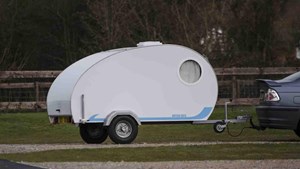 Some trailers and trailer tents don’t have brakes as they are relatively lightweight. Being able to tow a small unbraked trailer can be useful for camping, allowing extra kit and a large tent to be transported without eating up the passenger space in the tow car. This guide will cover the items you need to consider before taking an unbraked trailer on the road and other considerations while towing.
Some trailers and trailer tents don’t have brakes as they are relatively lightweight. Being able to tow a small unbraked trailer can be useful for camping, allowing extra kit and a large tent to be transported without eating up the passenger space in the tow car. This guide will cover the items you need to consider before taking an unbraked trailer on the road and other considerations while towing.
Considerations around the tow vehicle and the driver
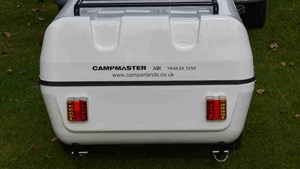 A vehicle suitable for towing will be approved by the manufacturer for this purpose and the handbook will provide limits for the gross weight of the unbraked trailer it is capable of pulling. A typical small car like the Nissan Micra can tow an unbraked trailer weighing no more than 350kg. It will also have a limit for a braked trailer, which will be higher. Further information is available in the matching car and caravan guide.
A vehicle suitable for towing will be approved by the manufacturer for this purpose and the handbook will provide limits for the gross weight of the unbraked trailer it is capable of pulling. A typical small car like the Nissan Micra can tow an unbraked trailer weighing no more than 350kg. It will also have a limit for a braked trailer, which will be higher. Further information is available in the matching car and caravan guide.
Towbar and trailer lights
A well fitted and maintained towbar is vital for safety. It must comply with EC Directive 94/20EC for vehicles first registered on or after 1 August 1998. It is the main connection between car and trailer. Although the towbar now falls within the remit of the MOT you should inspect the tow bracket regularly, checking for cracking or serious rusting and that the bolts are correctly tightened or get it checked out when the car is serviced. The trailer lights must work and the vehicle must have an indicator tell-tail system, which can be in a multitude of forms. The idea of a detachable towbar is that it should only be fitted when needed, and kept in the boot when not in use. Further information on Towbars and towing electrics are available in our guide here.
Advice your car insurer
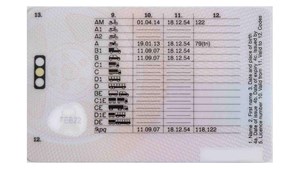 Adding a towbar to a car is classed as a modification that must be declared to the car’s insurance provider. If you use The Camping and Caravanning Club’s Club Care insurance provider you will automatically be covered, but other companies may make an additional charge. Your car’s insurance will then cover any third party damage while you are towing, but you will probably want separate trailer insurance to cover it and its contents against damage, fire and theft.
Adding a towbar to a car is classed as a modification that must be declared to the car’s insurance provider. If you use The Camping and Caravanning Club’s Club Care insurance provider you will automatically be covered, but other companies may make an additional charge. Your car’s insurance will then cover any third party damage while you are towing, but you will probably want separate trailer insurance to cover it and its contents against damage, fire and theft.
- Trailers and their towing vehicles should be in such a condition that they cause no danger to other road users.
- You may drive up to 60mph on motorways and dual carriageways. On all other roads the speed limit is 50mph unless lower limits are in force.
- Normal cars (Gross Vehicle Weight not exceeding 3,500kg) may tow a trailer up to a maximum body length of seven metres (not including draw bar) and width not exceeding 2.55 metres. It is highly unlikely that any unbraked trailers would fall foul of this.
- Assuming you can drive a car legally, no special categories are required on your driving licence to tow an unbraked trailer. The trailer has to have a gross weight of no more than 750kg. Further detailed information regarding driving licence and the limitations can be found in our guide to driving licences.
- Your trailer must carry a number plate with the registration number of the tow vehicle on it as well as red reflecting trailer triangles.
- Your unbraked trailer must have a secondary coupling that will keep the trailer connected to the tow vehicle in the event of it becoming detached.
- Passengers are not allowed to travel in a trailer while it is being towed.
- You must have a full driving licence to be able to tow, unless you have your B+E provisional licence and a qualified driver is in the vehicle.
- Towing vehicles must not use the outside lane of a three (or more) lane motorway even when overtaking, unless signs indicate otherwise or the nearside lanes are blocked by roadworks.
- Tyres must be capable of carrying the maximum permitted weight of the trailer and have a tread depth of no less than 1.6mm across the central three-quarters of the breadth of the tyre and around the entire circumference. See our tyres and tyre care guide for more information.
- Stopping overnight in a lay-by may be considered an obstruction. You could be asked to move on.
- If you park your trailer in the street overnight you must not park at parking meters and you must display lights all round.
- A trailer must not be left on the road uncoupled from its towing vehicle unless at least one wheel is effectively prevented from moving.
- If you carry anything on your trailer, like a bicycle, the load must be secured and not stick out dangerously.
Consideration around the trailer
Regulation
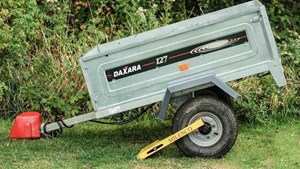 An unbraked trailer is categorised as an O1 trailer as defined in Type Approval 2007/46/EC and regulations concerning the use of trailers on UK roads are contained within Road Vehicles (Construction and Use) Regulation 1986.
An unbraked trailer is categorised as an O1 trailer as defined in Type Approval 2007/46/EC and regulations concerning the use of trailers on UK roads are contained within Road Vehicles (Construction and Use) Regulation 1986.
Components of a trailer
In the event the vehicle maker has not specified an unbraked trailer limit, Regulation 87 of Construction and Use will apply. This states the unbraked trailer may only be towed by vehicles having a kerbweight of at least twice the actual in use weight of the trailer.
Notwithstanding these requirements and like every vehicle that is taken on to the road the user is responsible for the roadworthiness of that vehicle.
Trailer body
This is the main payload carrying area of the trailer and could be constructed from metal, wood, fibre glass or a combination of these. Ensure that the body is firmly mounted to the trailer chassis, all door/tailgate are adequately attached and secured from opening on the move. Trailer covers can help keep the contents dry and secured while towing and keep the trailer clean, dry and tidy during storage. Some trailers sides can be extended upwards to allow for more load carrying, however this will eat into your user payload.
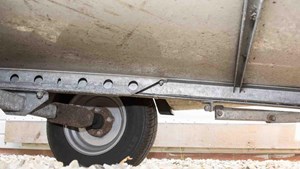 Trailer chassis and running gear
Trailer chassis and running gear
This is the part everything connects to so it should be regularly inspected by a competent person. Any concerns should be rectified before taking on the road again.
Ensure the trailer sits level in a no-load condition. Any deviation warrants further inspection of suspension (if fitted), wheel hubs and tyres.
Hitch coupling
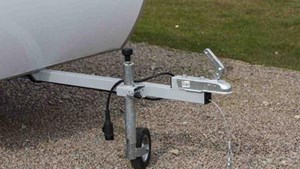 This is a critical part that connects the trailer with the towing vehicle. It must be well maintained and should attach positively and release easily. Often the head will have a coloured indicator to show when engagement is complete but it is worth winding down the jockey wheel until the back of the car is raised about 25 to 50mm to confirm a secure coupling.
This is a critical part that connects the trailer with the towing vehicle. It must be well maintained and should attach positively and release easily. Often the head will have a coloured indicator to show when engagement is complete but it is worth winding down the jockey wheel until the back of the car is raised about 25 to 50mm to confirm a secure coupling.
Small trailers are likely to have a wet connection where the towball should be lubricated prior to use. Most include a wear indicator for the 50mm towball. Regularly check the head for functionality and security.
Secondary coupling
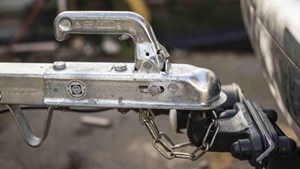 Unbraked trailers up to 750kg are required to have secondary couplings – normally a chain or thick cable that will keep the trailer attached to the towcar if the main coupling fails, allowing the combination to be brought to a stop safely. The skid on the underside of the drawbar tube should also prevent the trailer hitch touching the ground in the event of the main coupling failing. If the skid is not present ensure the secondary coupling will not allow the hitch to touch the floor in the event of a detachment.
Unbraked trailers up to 750kg are required to have secondary couplings – normally a chain or thick cable that will keep the trailer attached to the towcar if the main coupling fails, allowing the combination to be brought to a stop safely. The skid on the underside of the drawbar tube should also prevent the trailer hitch touching the ground in the event of the main coupling failing. If the skid is not present ensure the secondary coupling will not allow the hitch to touch the floor in the event of a detachment.
If no purpose designed attachment point is provided on the tow vehicle then it is acceptable to place the secondary coupling over the towball.
Note: A secondary coupling is not the same as a breakaway cable. This is designed to operate the brakes then shear or snap, allowing the braked trailer to stop away from the towing vehicle.
Tyres
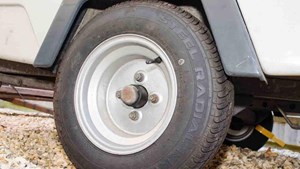 Basic checks of the tyres should form part of the routine carried out before and after a road trip. The most likely reasons a tyre will fail is excessive age and under inflation.
Basic checks of the tyres should form part of the routine carried out before and after a road trip. The most likely reasons a tyre will fail is excessive age and under inflation.
Check the tyres are at the correct pressure (check in handbook or speak to dealer). If no pressure figure can be found use the maximum tyre pressure stamped on the tyre sidewall.
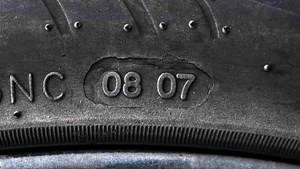 Trailer tyres used for leisure purposes are unlikely to wear out, however they could fail due to ageing. The Club recommends replacing tyres when they are no older than seven years, ideally at five years. They have a "made on" date stamped on one side of the tyre like the one in the picture opposite.
Trailer tyres used for leisure purposes are unlikely to wear out, however they could fail due to ageing. The Club recommends replacing tyres when they are no older than seven years, ideally at five years. They have a "made on" date stamped on one side of the tyre like the one in the picture opposite.
Payload and weight distribution
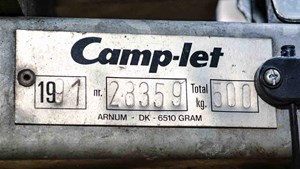 Most trailers have a weight plate attached, normally near the A-frame or drawbar. This will state the maximum weight the trailer is approved for. It may have other useful information such as the date of manufacture and serial number.
Most trailers have a weight plate attached, normally near the A-frame or drawbar. This will state the maximum weight the trailer is approved for. It may have other useful information such as the date of manufacture and serial number.
The payload forms part of this maximum weight. For example, if the trailer Mass in Service (MiS) is 200kg and the Maximum Authorised Mass (MAM) is 750kg then the user payload is 550kg. This payload is the weight of items you are allowed to carry in the trailer for personal use and for essential items such as extension sides, securing straps and kitchen utensils etc. You should find the figures in the handbook however it is good practice to confirm with your retailer what forms part of the basic MiS and what does not. For a trailer tent items like the sun canopy or bedroom annex are not likely to be included in the MiS. Check the loaded weight of your trailer on a public weighbridge or use a weighing device periodically to make sure that you are not exceeding the maximum trailer weight. Alternatively, weigh each individual item on the bathroom scales before loading, but don’t forget major weight components like gas cylinders, battery and spare wheel. Sometimes the spare wheel is standard equipment and hence within the unladen weight of the trailer or MiS, otherwise it is an optional extra with its weight coming out of your payload. Overloading can cause failure of vital components such as tyres. The payload should be kept evenly distributed between each side of the trailer. Heavier items should be positioned as close to the axle as possible for maximum stability.
Weight distribution around a small trailer can be tricky. Keep heavy items low down and over the axle, and do consider side to side weight distribution too. In all events keep heavy items away from the rear of the trailer as this will cause instability.
Noseweight
This is the mass imparted by the trailer to the towball of the car in a static and level condition. In most small trailers it is unlikely you would reach the limit of the tow car hitch however we recommend five to seven percent of the laden weight of the trailer should provide a stable trailer. Special gauges are available complying to BS7691 or use bathroom scales and a suitable length piece of timber to gauge the load.
Pre-use checks for unbraked trailers:
(some tasks may require assistance)
Before each journey check the following:
a) Tyre pressures. Are they at the correct pressure?
- See handbook, ask dealer, check tyre sidewall if all else fails
b) Tyre condition. Are they in good condition?
- Check the tread depth. 1.6mm is the legal minimum. We recommend replacement when worn to 3mm
- Check the side walls for signs of cracking and don’t forget the inside of the tyre
- Check for splits, cuts and foreign objects like screws or nails
c) Check the wheels. Are they in good condition?
- Check they are running freely
- Check the wheel nuts are tightened to the specified torque. If no information is available from the maker refer to the National Trailer and Towing Association (NTTA)
d) Check load is secure
e) Check door/tailgate is secure
f) Check gas cylinder valves are turned off (if used)
g) Steadies are raised and secured
h) Check noseweight is within car and trailer limits, adjust as required
i) Attach secondary cable securely
j) Attach coupling head to car towball and ensure it is fully engaged (and the green indicator is visible on some coupling heads)
- Check that the coupling head is firmly attached by attempting to lift the tow vehicles suspension by either:
i. Winding down the jockey wheel to put load on hitch
ii. Apply your body weight to rear of trailer
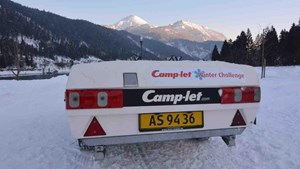 k) Raise and secured jockey wheel if fitted
k) Raise and secured jockey wheel if fitted
l) Check the road lights are working correctly
See also the Club’s Pre-journey checklists for a handy downloadable aide memoire for trailers on the technical help pages.
Regular maintenance checks for unbraked trailers:
At least once a year you should check the following areas in addition to the pre-use checks. If you don’t feel confident in performing these checks or for professional advice contact your local NTTA workshop
a) Check the suspension units for cracks in the welds of the wheel stub/arm
b) Check the wheel bearings run freely and they are not noisy or have excessive play. Grease if required and follow the manufacturer’s recommendation’s for further advice
c) If you have a trailer with Torsion Rubber Suspension units, check the overall condition of the unit. Look for signs of wear and ensure the bolts connecting them to the frame are secure and tightened to the correct torque
d) If you have a trailer with leaf springs, check for signs of wear, ensure that all the bolts are tightened to the correct torque. Check that none of the leafs are cracked or broken
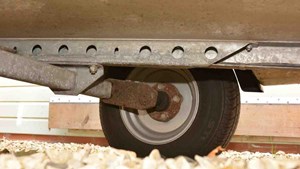 e) Check the underside of the trailer frame for cracks in the welds and that the base (ie the floor of the trailer) is in good condition
e) Check the underside of the trailer frame for cracks in the welds and that the base (ie the floor of the trailer) is in good condition
f) Check all chassis and running gear nuts and bolts for security
g) Check the condition of the sides of the trailer, look for any cracks in welds, and check the side walls are in good condition
h) Check and lubricate steadies if fitted
i) Check and lubricate jockey wheel assembly if fitted
j) Check spare wheel and tyre condition if appropriate
k) Check cover/lid condition. Check hinges on lids and elastic cord on covers
l) Check that the tow hitch is secure and the bolts are tightened to the correct torque
n) Check the condition of the electrical wiring. Is it frayed, broken or cracked? Repair or replace as required
m) Check the lights and bulbs are secure and not loose
o) Check the wheel arch or mud guard is in good condition and not catching or rubbing on the tyre
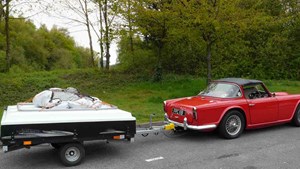 p) Check the lid, tailgate, cover and catches are in good condition and secure. Lubricate hinges as required
p) Check the lid, tailgate, cover and catches are in good condition and secure. Lubricate hinges as required
Be considerate while towing
- Towing a trailer may reduce the speed you would normally travel solo. If this leads to a build-up of traffic behind your unit, pull over when it is safe to do so, to allow faster vehicles to pass.
- Be aware of your speed when going up and down hills. Try not to stop, but use your vehicle’s gears wisely.
- Indicate well in advance if you intend overtaking or turning off the highway.
- Always try to anticipate what other drivers are likely to do.
- Allow plenty of space between your car and the vehicle in front.
- Be aware of oncoming traffic especially if a vehicle is indicating to turn across your lane.
- When parking, make sure you do so in a place that will not cause a nuisance to other travellers. If you park on an incline apply vehicle handbrake and keep trailer attached and ideally chock the wheels
- Small trailers can be very difficult to reverse however they are relatively easy to unhitch and manually manoeuvre into position as long as you have enough strength or help to do it without injury. Do keep some chocks handy too.
Top tip
The Camping and Caravanning Club runs manoeuvring courses that will help increase your confidence when travelling with your unit and positioning it. It's worth signing up for one.
